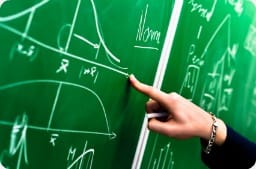Physics Teacher Certification

Why does an apple fall to the ground from a tree rather than float across the air, the way an astronaut’s pen would if he or she lets go of it while traveling through space? A physics teacher can tell you—and a whole lot more about how and why the universe works the way it does.
Physics is the study of different forms of energy and matter and the way they interact with each other through space and time. In this way, scientists use physics to explain how everything in the universe interacts with everything else. Without an understanding of physics, there is no space travel, no skyscrapers, and even no Internet!
On This Page…
| What is Physics Teaching Certification? |
| What do Physics Teachers do? |
| Why Physics Teachers are important |
| A Shortage of Physics Teachers… |
| Find Schools offering teaching certification programs |
The breadth and depth of physics can therefore be quite intimidating to students, many of whom have been known to quake at the mere mention of the subject. So it takes a hearty and dedicated person to become a physics teacher. The pay-off is that physics is fundamental to our understanding of how the world works, and consequently, physics teachers are among the most valuable additions to any student’s education. After all, none other than Albert Einstein, arguably the greatest contributor to modern thought, said, "Look deep into nature, and then you will understand everything better."
The physics teacher holds the key to our understanding of the universe; therefore, the physics teacher is a student’s passport to both the complexities and wonder of science, and one of the most essential components of an effective high school faculty. Certification as a physics teacher can open the door to this rewarding career.
What is Physics Teaching Certification?
Certification is the process by which aspiring teachers are evaluated for their ability to teach their subject. It is necessary to become a certified physics teacher because teaching is a position of public trust. Getting certified to teach physics is also important because physics is a highly complex subject and school districts want to make sure that their physics teachers are able to demonstrate not just a competency in the subject but also a mastery of it.
Though all physicists use both theory and practice, there are some differences between the ways physicists practice the field:
- Theoretical physics are the “thinkers” who focus on the principles that underlie the properties of the physical world.
- Experimental physicists are the “makers” who conduct experiments to gather data
The certification process therefore insures that those who become physics teachers can uphold the standards of their profession and serve their students, who may go on to college to study in any of the science fields, become medical practitioners, or even study philosophy.
Though certification requirements vary by state, those who wish to become certified physics teachers generally must complete at least a bachelor’s degree in physics or related science discipline from an accredited college or university. Although it is not always required, completion of an approved preparatory education program can be the most effective way to ensure that all education requirements have been met.
Following the completion of these academic credentials, aspiring physics teachers usually have to become certified by a state board of education. For those who decide to become teachers after college graduation, they can earn certification through an alternative program.
Once that is achieved, aspiring physics teachers’ academic qualifications must be assessed through either a Praxis or state board examination. Following successful completion of the state examination requirements, and sometimes the submission of letters of recommendation, transcripts, and demonstrations of teaching experience in teacher-training programs, a state licensure or certification to teach will be issued.
In many instances, certification in one state is governed by a reciprocity agreement with other states, which means teachers can transfer their certifications if they move. Learn more about the physics teaching certification requirements in your own state.
What do Physics Teachers do?
As with all varieties of teaching, physics teachers are responsible for:
- maintaining classroom control and discipline
- creating and delivering lesson plans
- creating and assessing homework, exams and other kinds of student work
- working with colleagues, administrators, and parents to ensure good educational outcomes for students
- maintaining current knowledge of both the field of physics and new educational methods
- ensuring that their classes fulfill larger curriculum goals, which in many instances are provided by state or school guidelines.
However, physics teachers are also responsible for knowing about a wide variety of topics in the field. For example, physics teachers must be able to explain that “matter” makes up all the physical substances that take up space in our world, such as our cell phones, cars, clothing, and the food we eat. Physics teachers must also be able to demonstrate how matter can change, as in when we eat and digest food. These are the properties and principles of matter.
Aside from Newton and Einstein, these physicists have also produced knowledge that has improved society:
- Galileo Galilei: perfected the telescope
- Nicola Tesla: invented AC power
- Marie Curie: discovered radium, which is used to kill cancer cells
- Guglielmo Marconi: invented wireless telegraphy, which led to the creation of radios.
In addition, physics teachers have the opportunity to explain some of the most revolutionary moments in the way scientists have discovered how the universe functions. Sir Isaac Newton’s discovery and explanation of how gravity works through his law of universal gravitation completely altered the way people understood the forces of nature. Einstein’s two theories of relativity explained the relationship between space and time in such a radically new way that the traditional foundations of philosophy, religion, and all our belief systems were challenged and, in some cases, abandoned.
By combining explanation and demonstration—the basics of the scientific method—physics teachers introduce some of the most important questions about nature and human existence to their students. This information can open the eyes of high school students to the larger world in which they exist.
One of the primary ways that physics teachers communicate information about these subjects is through classroom experiments that demonstrate the scientific principles. Physics teachers can use a wide variety of materials for classroom experiments, including everyday objects available around the house or school. For example, physics teachers use lab experiments such as these to engage students and help them learn how theories actually work in practice.
1. Bucket of Water: Physics teachers can illustrate Newton’s First Law of Motion with only a partially filled bucket of water. The pail should have a strong handle so that you can swing it in a vertical circle. The centripetal and centrifugal forces will keep the water from spilling out of the pail. While not as exciting as building rockets or volcanoes, the Bucket of Water exercise allows students to engage in hands-on activities that helps them learn the essential principles of physics.
2. Static Electricity Balloon: Everyone has done this at birthday parties: you take a balloon, rub it against your hair, and then stick the balloon on the wall, where by some magical process actually sticks to the wall. What most people don’t realize is that this isn’t magic at all: rather, it’s a great way to illustrate one the most basic elements of physics, the creation of energy through electricity. When you rub the balloon against your hair, you create an imbalance between negative and positive charges in objects. The positive charge created in the balloon is attracted to the wall’s electrons, so they stick together.
These are just two of the ways that physics teachers can teach through dynamic and exciting hands-on experiments in their classes. The opportunities to be creative are nearly endless, which makes teaching physics one of the most exciting fields of education.
Why Physics Teachers are Important
Physics teachers play a fundamental role in a student’s education. They not only help students learn about this important field of science, they provide opportunities for students to develop critical thinking skills that are valuable in any future career. However, one of the most important things high school physics teachers do is provide an important introduction to science that students can use as a foundation on which to build a career that will make important contributions to society. Physics is such a wide-ranging field that students have many different career options:
- Physics plays a fundamental role in medicine, specifically in areas that involve the diagnoses and treatment of diseases.
- Geologists and marine scientists who work on environmental conservation and the management of natural resources use physics.
- Physics students can become engineers and architects, prized for their abilities to apply physical principles to create buildings, computer programs, and new industrial products.
- Business and industry value physics majors for their abilities to translate abstract theories into practical applications. A fun example of this was in the film “Margin Call,” in which a corporate investor with a Ph.D. in physics saved a company from collapsing during a financial crisis.
The Physics Teacher Shortage
Cornell University recently highlighted the fact that the greatest teacher shortage in secondary education is in physics, which is one of the STEM (Science, Technology, Engineering, and Math) fields of research and instruction. In addition, among those who do teach physics, the majority are not actually qualified in the subject. This means that there are fewer students taking physics today, and that even those students who do take physics classes frequently do not get the appropriate instruction in the subject and fail to develop the necessary skills to go on to study STEM fields in college.
The effects of this have national ramifications. The federal government has identified this severe lag in scientific and technological knowledge as one of the primary factors affecting the growth and competitiveness of the United States economy. Therefore, science teaching is viewed by many as the key to expanding the national economy in the Information Age, because so many careers depend upon an understanding of physics. These careers include software engineering, nanotechnology, scientific writing and editing, air traffic control, oceanography, environmental conservation, communication technology, robotics, and a variety of government positions.
As a result of this severe shortage, physics has been identified as a “high need” position in American schools today. The shortage of qualified physics teachers means that there are bound to be many job opportunities opening up, especially as new education programs expand to increase student skills and raise student science knowledge to compete on an international level.
There are now a variety of incentives for becoming a certified physics teacher, and some groups, such as the American Association of Physics Teachers (AAPT), offer teaching materials, conferences and research opportunities, and a mentoring program to assist new physics teachers with any questions or problems that they experience in their first years as teachers.
For those who pursue teacher certification in physics, the rewards are multi-faceted. First, physics teachers help students develop high levels of critical and analytical reasoning, amass a considerable body of knowledge about the physical world, and prepare to major in a STEM field in college. Second, physics teachers, by training generations of students to think scientifically, also contribute to the continued growth and strength of the national economy. All in all, this makes physics teaching one of the most valued careers in education.






